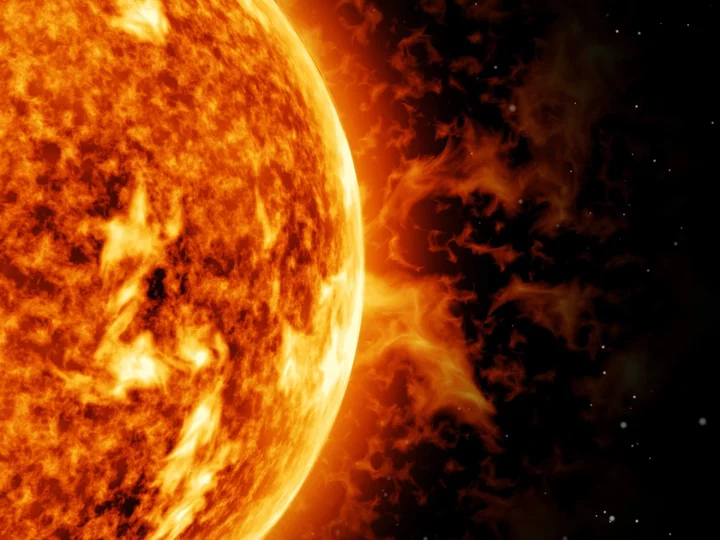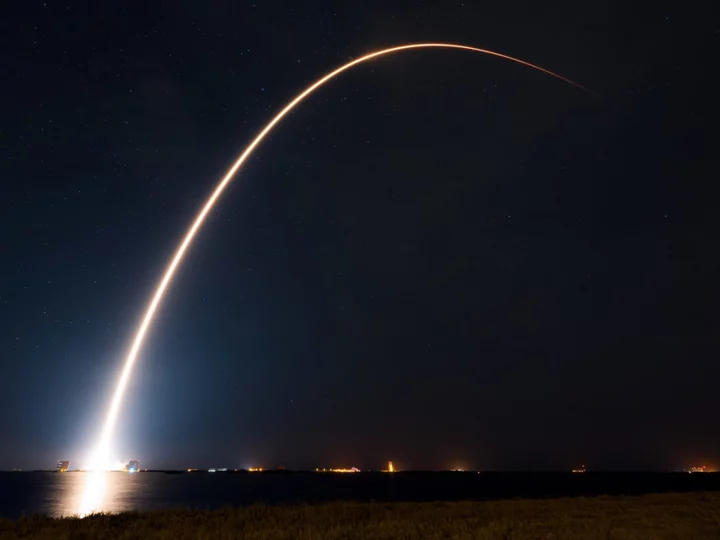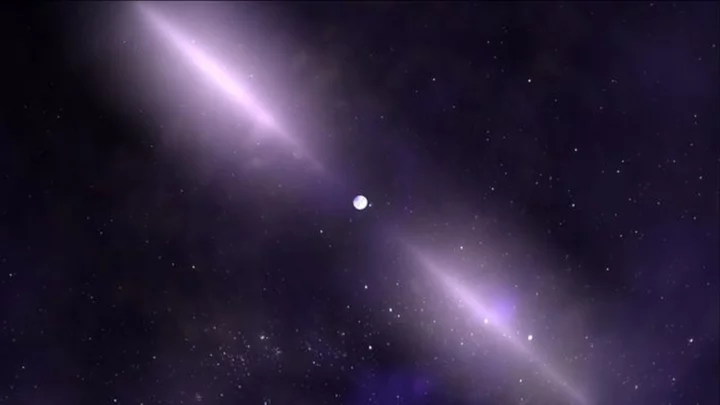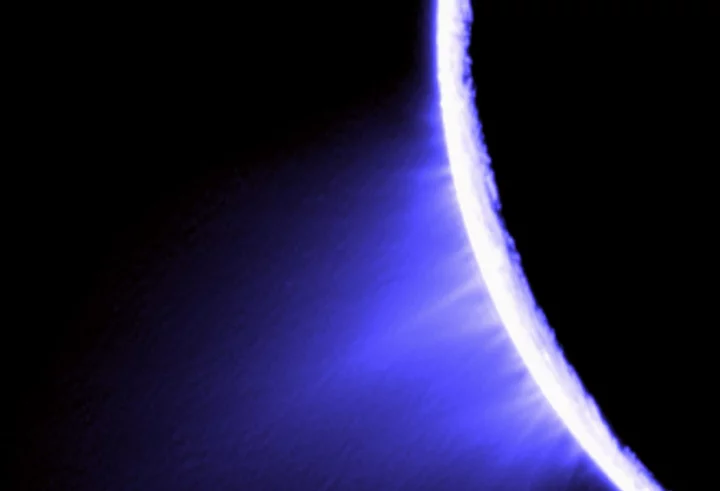
Powerful solar flare to disrupt communications, Russians warn
Russian scientists have warned that powerful solar flare activity on Monday may cause significant disruption for satellite and radio communications. Three solar flares observed on Sunday by the Fedorov Institute of Applied Geophysics in Moscow lasted up to 14 minutes, signalling abnormally large geomagnetic disturbances on Earth. The institute forecasted the arrival of class X flares for Monday, which are the most energetic type of solar radiation, capable of damaging electronics. Earlier this month, a giant sunspot named AR3354 grew to a size roughly 10 times larger than Earth, unleashing an X-class flare aimed directly at Earth that triggered radio blackouts in some parts of the US. The latest solar activity is expected to interfere with short-wave radio communications, used by military, maritime and emergency operators. Increased solar storm activity in recent years has led to fears of an impending solar superstorm, which some astronomers warn could lead to an “internet apocalypse”. Such powerful storms occur approximately once every 100 years, with the last major one taking place in 1921. Nasa predicts that the next peak in the Sun’s 11-year activity cycle will arrive at some point in 2025, though it is not clear yet whether this will be the once-in-a-century event that some astronomers fear. The worst on record, referred to as the Carrington Event, took place in 1859 and resulted in fires at telegraph stations. “If the Carrington Event happened today, it would have even more severe impacts, such as widespread electrical disruptions, persistent blackouts, and interruptions to global communications,” the US space agency warned in a recent blog post. “Such technological chaos could cripple economies and endanger the safety and livelihoods of people worldwide.” Research published in 2021 assessed the robustness of internet and communications infrastructure against severe space weather events The study found that coronal mass ejection events could risk disconnecting Europe from the US, with the authors urging more to be done to improve the resilience of global telecommunication networks. In March this year, Nasa announced a new artificial intelligence model capable of predicting where on Earth a solar storm may strike, giving scientists up to 30 minutes of advanced warning. Vishal Upendran, from the Inter-University Center for Astronomy and Astrophysics in India, who was involved in the AI’s development, said: “With this AI, it is now possible to make rapid and accurate global predictions and inform decisions in the event of a solar storm, thereby minimising – or even preventing – devastation to modern society.” Read More Once-in-a-century solar superstorm could plunge the world into ‘internet apocalypse’, study says Powerful solar flare responsible for blackout in US What to expect from India’s Chandrayaan-3 mission to Moon’s south pole India launches historic mission to Moon’s south pole
2023-07-17 19:57

‘Ghost stars’ have aligned themselves in a strange pattern in our galaxy – and scientists might now know why
“Ghost” stars are aligned in beautiful structures near the centre of our galaxy, scientists say – and they might finally be getting to know why. Researchers discovered the unusual alignment of these planetary nebulae ten years ago, when Manchester doctoral student Bryan Rees spotted them. But it has remained a mystery how they came to be that way. Now scientists have been able to confirm that unusual alignment. But they have also made a breakthrough in finding out why they are there, after they found that a particular group of stars known as binary stars is responsible. Planetary nebulae are gas clouds that are thrown out from stars when they come to the end of their life. Our own star, the Sun, will do the same in about five billion years. Those ejected clouds are like ghosts of their dying stars, and assemble themselves in beautiful shapes, researchers say, such as an hourglass or butterfly. Researchers studied a range of planetary nebulae that are near the centre of our Milky Way. Though they are not related and come from different stars and different times, many of their shapes are similar, lining up in the same way and on the same plane. In the new study, scientists found that the alignment happens when those ghosts have a close companion star. The companion orbits around the main star, at the centre of the planetary nebulae, at a very close orbit. Without such a companion star, the nebulae do not line up in the mysterious pattern. That suggests that the alignment is linked to the splitting of the binary components when the star is born. “This finding pushes us closer to understanding the cause for this mysterious alignment,” said Albert Zijlstra, co-author and professor in astrophysics at The University of Manchester. “Planetary nebulae offer us a window into the heart of our galaxy and this insight deepens our understanding of the dynamics and evolution of the Milky Way’s bulge region. “The formation of stars in the bulge of our galaxy is a complex process that involves various factors such as gravity, turbulence, and magnetic fields. Until now, we have had a lack of evidence for which of these mechanisms could be causing this process to happen and generating this alignment. “The significance in this research lies in the fact that we now know that the alignment is observed in this very specific subset of planetary nebulae.” Researchers looked at 136 confirmed planetary nebulae in the galactic bulge, or the thickest section of our Milky Way. They used the European Southern Observatory’s Very Large Telescope, and then looked at 40 more of them using images from the Hubble Space Telescope. The findings are reported in a new paper, ‘When the Stars Align: A 5 σ Concordance of Planetary Nebulae Major Axes in the Centre of our Galaxy’, in the Astrophysical Journal Letters. Read More Euclid: UK-backed mission ready to uncover mysteries of the dark universe Jeff Bezos’ rocket exploded and he didn’t tell anyone Nasa unveils ‘astrovans’ to carry Artemis moon mission astronauts Jeff Bezos’ rocket exploded and he didn’t tell anyone Nasa unveils ‘astrovans’ to carry Artemis moon mission astronauts Nasa releases James Webb telescope image on one-year anniversary
2023-07-14 01:47

Samoa media guide
An overview of the media in Samoa, including links to broadcasters and newspapers.
2023-07-11 20:53

SpaceX smashes reusable rocket record as Elon Musk makes bold Starship claim
SpaceX has broken its own record for launching reused rockets after successfully completing a mission to deliver its Starlink satellites into orbit. The company launched 22 of its internet satellites aboard a Falcon 9 rocket from the Space Force Station in Cape Canaveral, Florida, on Sunday night, before landing the first stage booster on a drone ship in the Atlantic Ocean. It was the 16th launch and landing for the B1058 Falcon 9 rocket booster, with SpaceX hoping it can achieve another four launches before finally being scrapped. The Starlink satellites were deployed into low-Earth orbit roughly one hour after lift-off, further boosting SpaceX’s space-based internet network. There are now more than 4,000 active Starlink satellites in orbit around Earth, delivering high-speed internet to users. The latest Starlinks are V2 Minis, which despite the name are larger than SpaceX’s previous generation Starlinks. The upgraded satellites include “4x more capacity per satellite than earlier iterations”, according to SpaceX. They are “mini” versions of the V2 Starlink satellites, which are set to launch aboard SpaceX’s giant Starship rocket as soon as it is operational. SpaceX recently completed a six engine static fire test of its Starship rocket at its Starbase facility in Texas, having failed in its first ever orbital mission earlier this year. The private space company has already secured multi-billion dollar contracts with Nasa to use the rocket as part of its Artemis lunar program, while SpaceX plans to use a fleet of the rockets to establish a permanent human colony on Mars before 2050. Shortly after the latest satellites were deployed, SpaceX boss Elon Musk provided an update for its next-generation space craft, which is the biggest rocket ever built. “Looks like we can increase Raptor thrust by ~20 per cent to reach 9,000 tons (20 million lbs) of force at sea level... And deliver over 200 tons of payload to a useful orbit with full and rapid reusability,” he wrote on Twitter. “Fifty rockets flying every three days on average enables over a megaton of payload to orbit per year – enough to build a self-sustaining city on Mars.” There is no fixed date for the next major orbital flight test of the Starship rocket, though Mr Musk has previously said that it will likely take place before September. Read More ‘It’s becoming like an airport’: How SpaceX normalised rocket launches New Meta app Threads ‘first credible threat’ to Twitter Euclid: UK-backed space mission takes off to uncover mysteries of dark universe SpaceX Starship completes six-engine static test fire at base in Texas
2023-07-10 19:23

TSMC Sales Ride AI Demand Boost to Beat Estimates
Taiwan Semiconductor Manufacturing Co. reported better-than-expected sales on a boom in artificial intelligence applications demanding more of the
2023-07-10 13:59

The Universe has sped up to an extreme level, scientists confirm
The universe went in “extreme slow motion” at its beginning, and has dramatically sped up since, scientists have found. The discovery, predicted by Einstein’s general theory of relativity, was finally confirmed after scientists observed the universe soon after the Big Bang. Einstein’s theory suggests that we should be able to see the distant universe, when it was much older than it is today, running much more slowly. But scientists have not been able to actually look that far and confirm the theory. Now scientists have used bright quasars as a sort of space clock, allowing them to measure time when the universe was much older than it is today. “Looking back to a time when the universe was just over a billion years old, we see time appearing to flow five times slower,” said Geraint Lewis from the University of Sydney, lead author on the new research. “If you were there, in this infant universe, one second would seem like one second – but from our position, more than 12 billion years into the future, that early time appears to drag.” Professor Lewis and other researchers gathered data from 200 quasars for the research. Quasars are very active supermassive black holes that sit in the middle of early galaxies, and hence provide a reliable way to look back at a much younger universe. Previous researchers have done the same using supernovae, or massive exploding stars. Those are useful but they are also difficult to see at the very very long distances of the early universe, meaning that the confirmation was limited only to about half the age of the cosmos. Now by using quasars scientists were able to look much further back, to just a tenth of the age of the universe, when it was only a billion years old. “Thanks to Einstein, we know that time and space are intertwined and, since the dawn of time in the singularity of the Big Bang, the universe has been expanding,” Professor Lewis said. “This expansion of space means that our observations of the early universe should appear to be much slower than time flows today. “In this paper, we have established that back to about a billion years after the Big Bang.” The work is described in a new paper, ‘Detection of the cosmological time dilation of high-redshift quasars’, published in Nature Astronomy. Read More Astronomers discover ‘shooting stars’ on the Sun Tonight’s ’supermoon’ will be biggest full moon of 2023 so far – here’s how to see it Euclid: UK-backed space mission takes off to uncover mysteries of dark universe Astronomers discover ‘shooting stars’ on the Sun Tonight’s ’supermoon’ will be biggest full moon of 2023 so far – here’s how to see it Euclid: UK-backed space mission takes off to uncover mysteries of dark universe
2023-07-03 23:30

The gutting of affirmative action is a 'clear and present danger' to equal education, critics say
The Supreme Court's landmark decision to bar colleges and universities from considering race as a specific basis for admission will make it more difficult for schools to achieve a diverse student population, civil rights leaders and education advocates say.
2023-06-30 00:47

Scientists find entirely new kind of gravitational wave in unprecedented breakthrough
Scientists have “heard” a chorus of gravitational waves rippling through the universe, in what they say is an unprecedented finding that could fundamentally change our understanding of the universe. The discovery, described in a range of newly published journal papers, suggests that spacetime is being rocked by intensely powerful gravitational waves all the time. Those waves carry a million times more energy than the one-off bursts of gravitational waves that were detected from a black hole and were themselves hailed as a major breakthrough in our understanding of the universe. The new results suggest that everything is being slowly shrunk and expanded by a new kind of gravitational wave as they pass through our galaxy. Scientists describe it as being akin to hearing a “symphony” of waves echoing through the universe. “It’s like a choir, with all these supermassive black hole pairs chiming in at different frequencies,” said Chiara Mingarelli, a scientist who worked on the new findings while an associate research scientist at the Flatiron Institute’s Center for Computational Astrophysics. “This is the first-ever evidence for the gravitational wave background. We’ve opened a new window of observation on the universe.” The new findings have been described in a range of journal articles, published in different academic journals. The research is the result of 25 years of observations from six of the world’s most sensitive radio telescopes, and have been simultaneously published by different collaborations across the world. The findings are not only notable in themselves. They also offer the opportunity to find out some of the universe’s secrets, since they can be used to find information about the binary black holes that form when galaxies merge, for instance. “These results signify the beginning of an exciting journey into the Universe, where we aim to unravel its mysteries,” Michael Keith, a lecturer at Jodrell Bank Centre for Astrophysics, UK, and contributor to one of the new studies, published in Astronomy and Astrophysics. “After decades of tireless work by hundreds of astronomers and physicists worldwide, we are finally detecting the long-awaited signature of gravitational waves originating from the distant Universe.” Scientists made the discovery by analysing observations of pulsars, which are extinguished stars that can be used as reliable clocks in the distant universe. By bringing together such a large amount of detailed data, researchers were able to measure those pulsars with very high accuracy, allowing them to measure gravitational waves at a far larger scale than using detectors on Earth. “Pulsars are excellent natural clocks. We exploit the remarkable regularity of their signals to detect subtle changes in their rhythm, enabling us to perceive the minute stretching and squeezing of space-time caused by gravitational waves originating from the far reaches of the Universe,” said David Champion, a senior scientist at the MPIfR in Bonn, Germany, and contributor to the study, in a statement. For now, researchers are only able to “hear” the vast choir, rather than the individual pulsars that make up its singers. But together they are much louder than expected, meaning that there may be more or more heavy supermassive black holes to be found in the universe. Read More Astronomers find zombie planet that ‘shouldn’t exist’ Nasa to begin Moon mining within next decade Nasa rover spots bizarre donut shaped rock on Mars
2023-06-29 08:19

Astronomers find zombie planet that ‘shouldn’t exist’
Scientists have found a new planet they shouldn’t exist, after it seemed to miraculously survived the violent death of its star. Many planets, including our own, face almost certain doom when their stars reach the end of their lives and engulf them. When our own Sun dies, for instance, it will expand to 100 times and swallow the Earth. But the new study offers hope that at least some of those planets are able to survive. The newly discovered world, a Jupiter-like planet known as Halla, managed to survive the demise of its star Baekdu, in what should have been certain death. Astronomers found the planet and discovered through follow-up observations that Baekdu had previously expanded into a red giant. When it did, it would have inflated up to 1.5 times the distance between it and Halla, engulfing the star, and then shrunk back down to its current size. Despite that dramatic and violent event, Halla has managed to persist, sticking around so that astronomers could see it using telescopes in Hawaii. “Planetary engulfment has catastrophic consequences for either the planet or the star itself - or both. The fact that Halla has managed to persist in the immediate vicinity of a giant star that would have otherwise engulfed it highlights the planet as an extraordinary survivor,” said Marc Hon, the lead author of the study. The findings are published in a new paper, ‘A close-in giant planet escapes engulfment by its star’, in the journal Nature today. Halla was found in 2015, using what scientists call the “radial velocity method”, which monitors how stars move and uses that to understand how they might be tugged around by the planets that orbit them. In the years since, scientists found that the planet must have been engulfed by the star, and conducted follow-up observations to better understand the planet. Those observations confirm that the planet had been in its stable orbit for over a decade, and that it really existed. “Together, these observations confirmed the existence of the planet, leaving us with the compelling question of how the planet actually survived,” said IfA astronomer Daniel Huber, second author of the study. But scientists still do not know how it survived. One possibility is that it started on a larger orbit before moving closer to its star, but astronomers believe that is unlikely. Another is that Baekdu was actually once two stars. They may have merged during their death, sparing Halla from being merged at all, by stopping them getting big enough to engulf it. And a separate possibility is that Halla was actually born out of the collision of the two stars. That might have produced a gas cloud that actually gave birth to Halla, and so it may be the result of the demise of its star rather than a survivor of it. Read More Nasa rover spots bizarre donut shaped rock on Mars Strange alien planet could be trapped in edge of the Solar System SpaceX Starship completes six-engine static test fire at base in Texas
2023-06-28 23:26

Palau media guide
An overview of the media in Palau, including links to broadcasters and newspapers.
2023-06-27 19:49

Our nearest supermassive black hole ‘became active’ and became a million times intense, scientists say
Our nearest supermassive black hole awoke from a “period of dormancy”, becoming a million times more intense, scientists have said. The supermassive black hole, known as Sagittarius A*, sits at the heart of the Milky Way and is about four million times more massive than the Sun. About 200 years ago, it ate cosmic objects that got too close to it and became vastly more bright, scientists found. The increase in brightness is as if a single glow-worm hidden in a forest suddenly became as bright as the Sun, according to researchers. The intense event was discovered by scientists who picked up an X-ray “echo” from the event. It also explains the intense bright shine of galactic molecular clouds around the black hole – scientists say they are reflecting those X-rays that came out of the black hole towards the start of the 19th century. The work is described in a new paper, ‘X-ray polarization evidence for a 200 years-old flare of Sgr A*’, published in Nature. Read More Jupiter is struck by neon green lightning bolt in stunning Nasa photo Humans have affected the Earth’s rotation, scientists say First disabled astronaut says his selection sends ‘powerful message’
2023-06-21 23:18

Major finding on Saturn moon boosts hope for finding alien life nearby
Phosphates have been found on Saturn’s moon Enceladus, in a new breakthrough discovery that boosts hopes for finding alien life in our solar system. It is the first time phosphorus has been found in an ocean beyond those on Earth, and marks a major development in our understanding of other ocean worlds. Enceladus is one of the most likely hopes for finding nearby extraterrestrial life. While its outside is wrapped in an ice crust, underneath is a global ocean that could be a home for alien life. Some of that ocean spews up and out of the surface of Enceladus, in the form of vast plumes. Scientists have been able to examine those plumes to better understand the ocean itself, including in the new study. Researchers in the latest study used data from the Cassini mission – which flew around Saturn and Enceladus – to find out what the oceans are made up of. They not only found phosphorus, but data suggested that it could be there are concentrations at least 100 times higher than in Earth’s oceans. What’s more, modelling based on the new data suggests the same could be true for other ocean worlds, potentially boosting the chances of alien life there, too. Phosphorus is not in itself evidence of life. But on Earth, the presence of phosphorus compounds in water are crucial for biological activity, and so it is a key part of evaluating whether a distant world might support life. The work is described in a new paper, ‘Detection of phosphates originating from Enceladus’s ocean’, published in Nature. The breakthrough is just the latest in a series of findings from Enceladus. Recently, scientists found that the moon’s plumes were particularly vast, shooting out 20 times the length of the planet itself and with enough water to fill an olympic swimming pool in a couple of hours. Unlike the new phosphorus findings, which relied on the Cassini spacecraft sent by Nasa to Saturn, that work was conducted by the James Webb Space Telescope, which scientists hope will allow us to understand the distant moon in much more detail. Read More Watch: Strawberry moon lights up skies over UK Nasa invites public to sign ‘message in a bottle’ that will fly to Jupiter’s moon Watch as astronauts step out of ISS for latest spacewalk
2023-06-16 04:58
